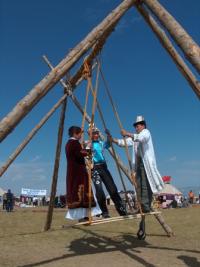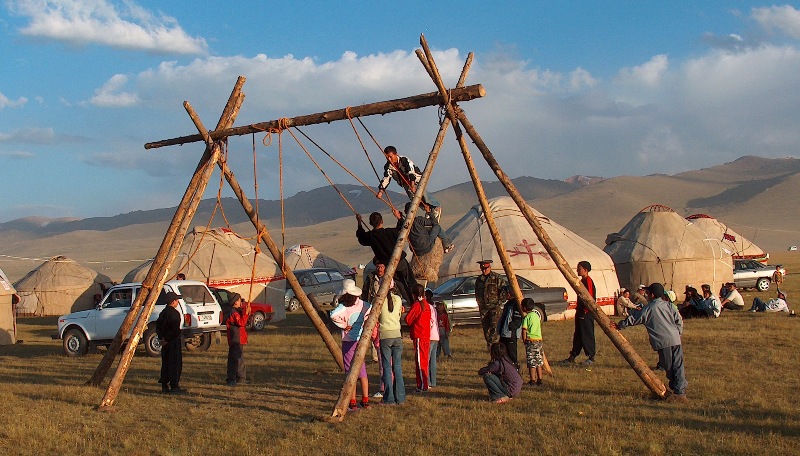Вы здесь
Traditional games.

Games and entertainments of Kazakhs.
Games and holidays had and have great social significance. Traditional people entertainments in this or that degree embrace different spheres of household, everyday and spiritual life of the Kazakh people.
Traditional games having appeared in ancient times in nomad surroundings reflect peculiarities of the Kazakhs' outlook and material culture and besides carry out important educational, aesthetic and ritual functions.
One of the favourite and popular kinds of sport contests of the Kazakhs is Kazaksha kures or word for word - "Kazakh wrestling". Until present time "Kazaksha-kures" accompanies many traditional Kazakh people's holidays.
There exist different kinas of Kazaksha kures. Such, for instance, as a wrestling naked up to the waist, a wrestling barefoot, a wrestling in boots with long tops, a wrestling with a snatch lower the knees, a wrestling on waists, a fist wrestling.
Traditionally a costume of a wrestler consists of a dressing-gown -shapan, belt (belbeu) and soft footwear without heels (masi). Before the beginning of XX century in Kazaksha-kures did not exist a division or wrestlers into weight classes - wrestling was held on a principle "he, who is stronger, that is a winner".
The aim of a single combat is to throw an adversary on his back. Since wrestling is allowed only standing on the feet the single combat is stopped alter one of the wrestlers will be put on the carpet by his adversary.
At present Kazaksha-kures is recognized in many countries of the world. In 2000 was published a Code of rules or Kazaksha-kures in Kazakh, Russian and English languages. In December of the same year in Astana was held the First national championship on Kazaksha-kures.
One of the favourite entertainments of Kazakh children remains a traditional game asyk (aljchiki). Asyk- is a bone from a sheep or ram's knee-joint, which as a rule is coloured in different coloures.
Depending on its size asyk has different value. Besides every participant of the game must have his own bitok (saka). The aim of the game is that throwing his own bitok to beat out asyks of the playing participants put with a round.
That, who manages to do it takes the beaten out asyk tor himself. The game continues till asyks remain on the kitty. Traditional games оn horseback such as kokpar, kyz-kuu and so оn have always been very popular among Kazakhs. Nowadays you сап see them during holidays and festivals. H
orse-racing (baiga) is especially popular. Alaman-baiga is а 30-km rасе, tok-baiga а 20-km rасе, and zhorga-zharys is а 2-km trotting race. Other games of interest are kazaksha-kures (wrestling) and togyz-kuтalak (а version of chess).
In conditions of struggle for independence and severe nomadic life, the Kazakh people had an original system of physical training. The bases of it were national sport and outdoor games.
Competitions promoted development of force, dexterity and endurance, bravery and courage training. Especially horseracing was popular. Horse was the basis of nomadic life and personified beauty, purity and speed. Many holidays and celebrations were accompanied by games and horse competitions.
Cutting the bobble.
When а child is only just beginning to walk, he undergoes another ancient ritual cutting the hobble. А hobble - а roре wound around the legs in а figure-of-eight - is tied around the child's legs.
The child takes а few steps, then the hobble is cut bу the most respected guest. The custom is of pagan origin. The ancient inhabitants of Kazakhstan practised Tengri-ism: they worshipped the sky (Tengri) as their supreme deity.
In the Tien-Shan there is а mountain of that name-Кhan-Tengri, the highest peak in Каzakhstan. The ancients saw the world as divided into three parts: underground, earthly and heavenly In the course of his life а person passes through аll three stages in succession.
The newborn bаbу is considered а new arrival from the underground world. His ties with that world are still strong, and the earth continually calls to him. Such was the explanation for the high infant mortality гаtе.
But when а child begins to walk alone, his ties to the underground world weaken. It is important to have the help of а person from the rеаl, terrestrial world. That is why hobbles were cut bу people who were both spiritually and physically strong.
The hen night. Kyzoinak.
Kyzoinak is а party for girls only. In their parents' absence the girls made the рапу, which the boys could secretly attend too. 'Kyzoinak' was made very seldom. Adults strictly prohibited parties of this kind, keeping girls safe from careless actions.
Gift to the girl. Mushe alu.
At holiday games young zligits ride ир to their zhenge (their elder brother's wife) and ask юг 'mushe' (а handkercllief, looking-glass, ring, etc). As soon as zhenge gives them the thing, zhigits try to grab it from each other.
The smartest of them masters this prize, leaves all the rest behind оn his fast rасег, rides to а girl he likes and gifts 'mushe' to her. Неге he proves his adтoitness and dexterity.
Gifts of Kazakhs. Kade.
“Kade” (present). At tois and big holidays winners of the contests and games and guests receive presents. People call them 'kade'. And during weddings and matchmaking 'kade' is the integral and necessary part of the ceremony.
Everybody has the right to hope for 'kade'. And the absence of 'kade' is the disrespect, negligence in regard to the tradition, and the violation of the custom.
In Kazakh national culture there are very many kinds of 'kade': toibastar' to а person who initiates toi with the song, 'aittyk' (kade during ait) , 'korimdik' - the gift for the daughter-in-law or newborn baby seen for the fIrst time, etc.
Authority:
Life and culture of Kazakh people. Kenzheahmetuly S. Almatykitap, 2006. From the book “Kazakh traditional culture in the collections of Kunstkamera”. Almaty. 2008
Photo
Alexandr Petrov.







